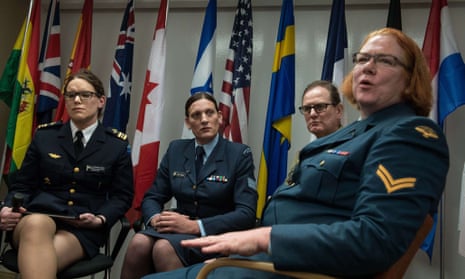Note4Students
From UPSC perspective, the following things are important :
Prelims level: NALSA Judgment
Mains level: Transgender Persons (Protection of Rights) Act (2019)
Central idea
The central idea revolves around advocating for the gradual and thoughtful inclusion of transgender individuals in the armed forces. By drawing parallels with successful women integration, proposing protected roles initially, and emphasizing social awareness, the approach aims for a balanced, transparent, and inclusive transformation within the military, recognizing and addressing historical discrimination.
Key Highlights:
- Growing Acceptance: People are becoming more accepting of transgender folks, which is a positive change. Society is starting to understand the importance of including everyone, regardless of their gender identity.
- Recognizing Challenges: We’re acknowledging that transgender individuals have faced a tough time with discrimination, stigma, and fewer opportunities. This recognition is crucial in addressing historical disadvantages.
- Legal Steps in India: India has taken legal steps, like the Transgender Persons (Protection of Rights) Act in 2019, to protect transgender rights. This shows a commitment to making things better since a significant judgment in 2014.
- Armed Forces Proposal: There’s a suggestion to include transgender individuals in the armed forces. This proposal comes from the realization that they’ve been at a disadvantage and need proactive help to be part of every aspect of life.
- Stepwise Integration Approach: The idea is to include transgender individuals gradually, just like how women’s roles in the armed forces expanded step by step. This way, we can be sure that we’re ready and set up for their inclusion.
- Learning from Women’s Inclusion: We’re learning from how women were included in the armed forces. By doing this, we hope to avoid problems and make the integration process smooth and successful.
- Roles for Transgender Personnel: Transgender individuals might start with roles in medical services and staff positions. Initially, these roles will be more protected to ensure they feel comfortable and respected.
- Social Awareness Emphasis: There’s a suggestion to make the armed forces more aware of societal justice and the discrimination faced by transgender individuals. This change in mindset is vital for a successful integration.
Key Challenges:
- Societal Prejudices: A challenge is dealing with society’s biases within the armed forces. Overcoming these biases is crucial for creating an inclusive environment.
- Balancing Inclusion with Discipline: We need to be careful about how inclusion might affect the strong discipline and camaraderie in the armed forces. Balancing inclusion with maintaining teamwork is a tricky but necessary challenge.
- Infrastructure Support: Developing the needed support for transgender individuals is important. This includes making sure the armed forces are ready and equipped for their inclusion.
- Dignity Concerns: We’re aware of concerns about respecting the dignity and self-respect of transgender individuals. To address this, there’s a proposal for more protected roles initially.
Key Terms and Phrases:
- Camaraderie and Discipline: The armed forces have strong bonds based on trust and teamwork. Keeping these bonds intact while embracing diversity is a challenge.
- Sensitization Road Map: We’re planning a roadmap to sensitize the armed forces at all levels. This means we want everyone to understand and accept the realities of discrimination.
- Competence and Capabilities: Transgender individuals should be accepted based on their skills and abilities. Competency and capability are what matter most.
- Sheltered Appointments: Initially, there’s a proposal for more protected roles to make sure transgender individuals feel secure and respected.
- Aide-de-Camp: Imagining a capable transgender officer in a prestigious role shows the positive impact they can have on perceptions and acceptance.
- Gradual Integration: Just like how women were gradually included, we’re looking at a step-by-step approach for transgender integration.
Key Facts and Data:
- NALSA Judgment as a Legal Milestone: In 2014, there was a significant decision recognizing and protecting transgender rights. This decision set the stage for later legal measures.
- Transgender Persons (Protection of Rights) Act (2019): In 2019, India took legislative steps to protect transgender rights. These measures show a commitment to making things better.
- Success of Women in Armed Forces: We’re looking at the achievements of women in the armed forces as a guide for including transgender individuals. Learning from past successes helps us avoid problems.
Critical Analysis:
- Acknowledging Historical Discrimination: We’re recognizing that a big change is needed in the armed forces’ way of thinking. This acknowledgment sets the stage for real change.
- Calibrated Approach to Integration: We’re emphasizing the importance of careful planning and a step-by-step approach. This ensures that inclusion happens smoothly.
- Learning from Women’s Inclusion: We’re learning from how women were included in the armed forces. This shows a readiness to apply lessons from one integration process to another.
- Impact on Discipline and Camaraderie: We’re considering how inclusion might affect the unique bonds within the armed forces. This balance is crucial for a successful integration.
- Recognizing Importance of Social Awareness: We’re identifying the need for the armed forces to understand societal justice. This change in mindset is vital for true and lasting change.
Way Forward:
- Advocating Wider Discussions: We’re suggesting more discussions and debates within the armed forces. This ensures that everyone’s perspective is considered.
- Gradual Expansion of Roles: We’re advocating for more roles based on abilities and merit. This ensures that everyone gets opportunities based on their skills.
- Involvement of Transgender Community: We’re suggesting that the transgender community should be part of decision-making. This makes sure their views are central to the integration process.
- Establishing Social Awareness Strategy: We’re emphasizing the need for a strategy to make the armed forces more aware. This ensures that everyone understands and accepts the need for change.
- Transparent and Just Process: We’re highlighting the importance of openness and fairness in the integration process. This ensures that the process is respectful and just for everyone involved.
Get an IAS/IPS ranker as your 1: 1 personal mentor for UPSC 2024

